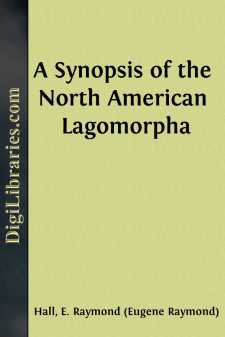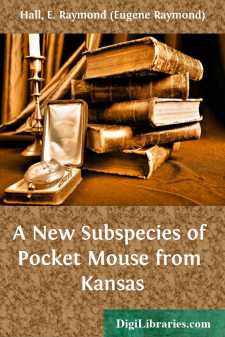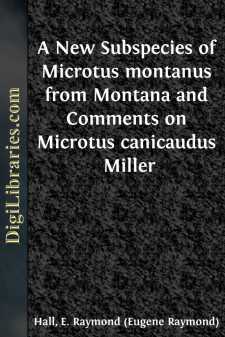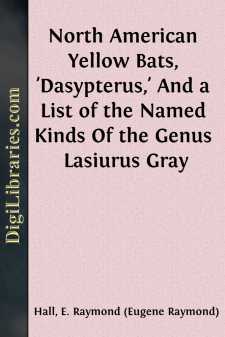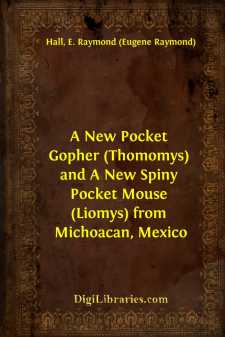Categories
- Antiques & Collectibles 13
- Architecture 36
- Art 48
- Bibles 22
- Biography & Autobiography 813
- Body, Mind & Spirit 141
- Business & Economics 28
- Children's Books 12
- Children's Fiction 9
- Computers 4
- Cooking 94
- Crafts & Hobbies 4
- Drama 346
- Education 46
- Family & Relationships 57
- Fiction 11826
- Games 19
- Gardening 17
- Health & Fitness 34
- History 1377
- House & Home 1
- Humor 147
- Juvenile Fiction 1873
- Juvenile Nonfiction 202
- Language Arts & Disciplines 88
- Law 16
- Literary Collections 686
- Literary Criticism 179
- Mathematics 13
- Medical 41
- Music 40
- Nature 179
- Non-Classifiable 1768
- Performing Arts 7
- Periodicals 1453
- Philosophy 64
- Photography 2
- Poetry 896
- Political Science 203
- Psychology 42
- Reference 154
- Religion 513
- Science 126
- Self-Help 83
- Social Science 81
- Sports & Recreation 34
- Study Aids 3
- Technology & Engineering 59
- Transportation 23
- Travel 463
- True Crime 29
Conspecificity of two pocket mice, Perognathus goldmani and P. artus
Description:
Excerpt
Perognathus goldmani Osgood and Perognathus artus Osgood from southern Sonora, northern Sinaloa and adjoining parts of Chihuahua and Durango, are two named kinds of the Perognathus intermedius group of pocket mice, of the subgenus Chaetodipus. Until now the two kinds have been treated in the literature as two species. In both goldmani and artus the upper parts are Ochraceous-Buff (capitalized color terms after Ridgway, Color Standards and Color Nomenclature, Washington, D. C., 1912) having a strong admixture of black. The lateral line is Ochraceous-Buff, and the underparts are white. P. goldmani is larger than P. artus (see measurements beyond) and has more inflated tympanic bullae and a relatively narrower (transverse to long axis of skull) interparietal bone.
Specimens from a transect of southeastern Sonora show intergradation between Perognathus goldmani and P. artus. From northwest to southeast the specimens are as follows: one mile east of Buena Vista, on RÃo Yaqui Reservoir, 1000 feet (2 specimens, K. U.); Alamos, 1200 feet (7, U. S. B. S.); four and a half miles southeast of Alamos, 1000 feet (5, K. U.); nine miles southeast Alamos, 1000 feet (5, K. U.). The specimens (P. goldmani) from RÃo Yaqui Reservoir are largest. Those from nine miles southeast of Alamos (P. artus) are smallest. Those from Alamos proper are P. goldmani. Those from four and a half miles southeast of Alamos (80051-80055 K. U. collected by Robert L. Packard and here referred to goldmani) include two as large as goldmani from Alamos, one as small as artus from nine miles southeast of Alamos, and two that are intermediate in size. Features other than size, considered geographically, also suggest intergradation.
Six specimens (61409-61413, 61415 K. U. collected by J. R. Alcorn), including five adults (permanent fourth premolar of full height and having cusps worn but not so much as to make a lake of dentine), from four miles north of Terrero, Sinaloa, also seem to be intergrades between Perognathus goldmani and Perognathus artus. As compared with adults of P. goldmani from 10 miles north-northwest of Los Mochis, Sinaloa, and P. artus from one mile south of Pericos, Sinaloa, the specimens from four miles north of Terrero are almost exactly intermediate in length of hind foot, width of interparietal, and width of tympanic bullae. Intermediacy is shown also in total length of animal (slightly nearer that of artus) and length of tympanic bullae (slightly nearer that of goldmani). In lack of inflation laterally of the mastoidal bullae the specimens agree with artus. In occipitonasal length and mastoidal breadth the specimens from four miles north of Terrero average even larger than goldmani from 10 miles north-northwest of Los Mochis but not so large as specimens of goldmani from the type locality, which is still farther north. The uninflated mastoidal bullae "tip the balance" slightly in favor of artus to which the specimens from four miles north of Terrero are here referred. The degree of inflation of the mastoidal bullae elsewhere varies geographically....



